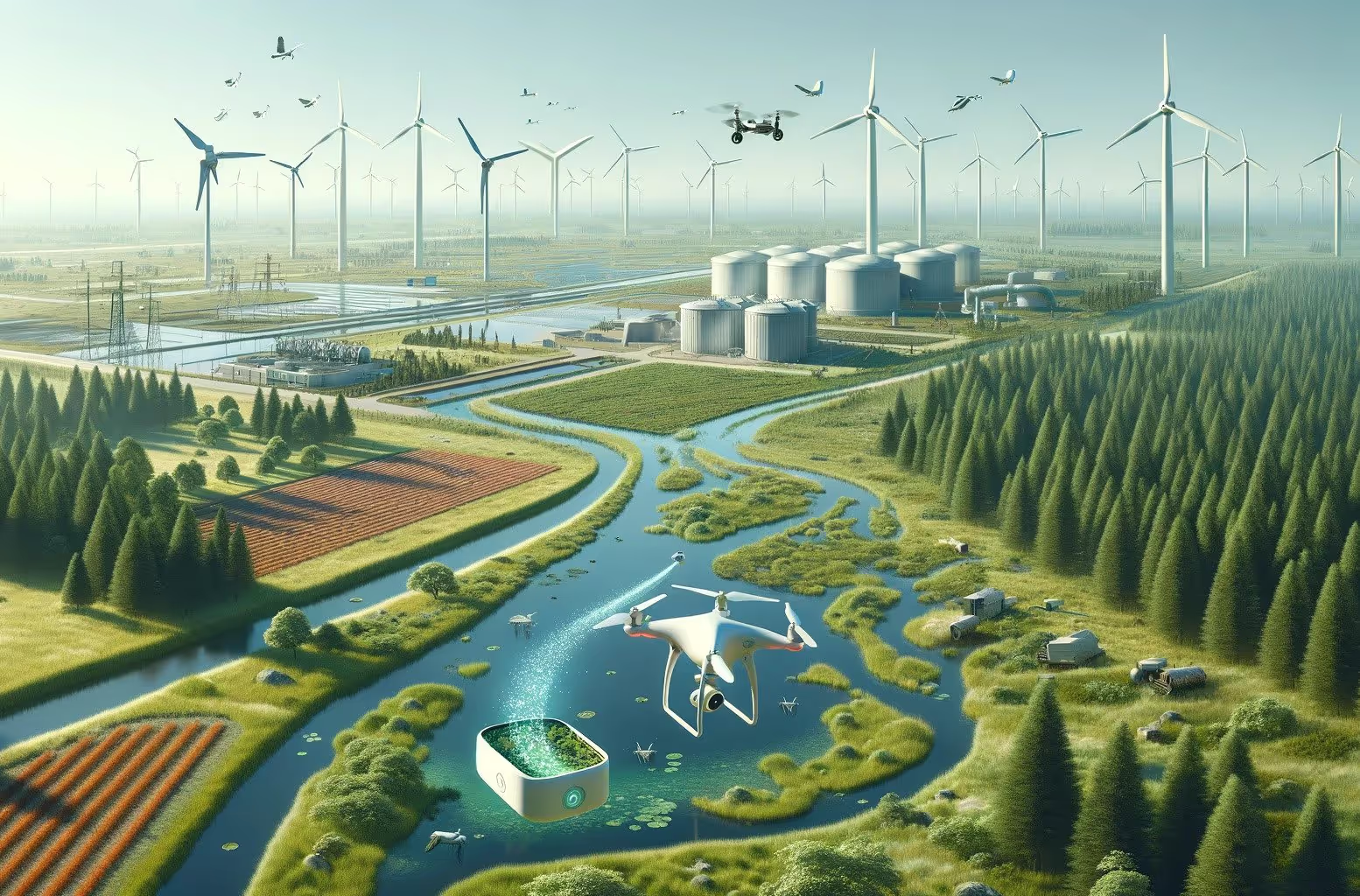Harnessing AI for Environmental Sustainability


In an era where environmental stewardship is more critical than ever, nations and organizations worldwide are making bold commitments to achieve net zero emissions and preserve or restore natural habitats. At first glance, artificial intelligence (AI) may seem at odds with this mission due to its significant energy requirements. However, when harnessed effectively, AI can be a valuable tool in advancing environmental sustainability. By optimizing complex processes, automating time-consuming tasks, and providing valuable insights, AI enables us to focus our efforts more efficiently and accelerate progress. These benefits span across various environmental domains, from renewable energy to biodiversity conservation. Let's explore some of the use cases where AI is making a difference.
Land Conservation and Restoration
Land conservation and restoration is a key part of environmental sustainability, globally 6% of the planet's land has undergone land cover change between 2000 and 2020, a clearly unsustainable trend. To meet sustainability targets we don't only need to conserve existing natural habitats but also restore degraded ones. The benefit of doing so is not only to preserver biodiversity for plants and animals but also either reduce carbon emissions or even capture them.
At New Gradient, we have partnered with a leading Scottish company in the peatland restoration space to help improve peatland mapping. Peatland erosion silently contributes to carbon emissions and restoring degraded peatland can prevent this. In 2019, UK peatland emissions were estimated at 23.1 million tonnes of carbon dioxide equivalent (Mt CO2e), contributing 3.5% to total UK emissions [1], with Scotland having an even higher proportion. This underscores the urgent need for restoration efforts.
To address this challenge, our AI developers created an automated mapping tool utilizing drone imagery and AI to swiftly map erosion features. Our machine learning engineers adapted state-of-the-art transformer architectures for computer vision tasks, making key architectural adaptations to existing models to achieve human-level AI erosion mapping. This innovation significantly expedites the erosion mapping process, potentially saving restoration projects thousands of pounds and countless human hours over the lifetime of a project, laying a solid foundation for restoration planning.
By leveraging our technology to provide insights to investors and landowners, we aim to make peatland restoration less risky, more profitable, and eventually more common, helping to increase the number of active projects and further reduce carbon emissions.
Renewable Energy Producers
The renewable energy transition is crucial for achieving a sustainable, net zero world. Building, delivering, and maintaining renewable energy infrastructure is a mammoth task that AI can help deliver on time for the benefit of our planet. AI can be used across the process, from planning renewable energy projects to building the most effective and efficient infrastructure, making delivery as lossless as possible, and maintaining the infrastructure to the best possible degree.
Examples of AI's uses include optimizing wind farm design layouts and placements by better identifying obstacles to turbine placement and optimizing layouts given the terrain conditions and types of turbines. Once erected, AI can dynamically adapt turbine settings, such as blade pitch and yaw angles, to maximize energy capture and raise overall efficiency.
AI also enables predictive maintenance by analysing data from sensors mounted on turbines. AI algorithms can be trained to identify if a turbine is damaged or likely to fail, signalling the need for maintenance, reducing downtime, and increasing clean energy production.
Sustainable Agriculture
In agriculture, AI is driving sustainable practices by optimizing resource utilization and enhancing productivity. AI algorithms can better predict weather patterns, optimize irrigation schedules, and minimize the use of fertilizers and pesticides. Companies like Drone Ag in the UK are utilizing AI to analyze crop images captured by drones, empowering farmers to make data-driven decisions that reduce environmental impact while maximizing yields.
Waste and Water Management
AI can be integrated into waste and water management in various ways. In waste and recycling, computer vision algorithms deployed alongside simple robotics systems can sort recycling into more specified categories, reducing human input and sorting costs.
For water management, AI can identify manhole covers from aerial imagery, improving maintenance efforts and saving costs, especially for poorly mapped assets on private property. AI can also predict watershed movements based on weather conditions, informing wastewater management procedures. Finally sewage treatment plants can be optimized by leveraging real-time sensor data on water quality, flow rates, and energy consumption to adapt operational parameters and reduce energy requirements.
Biodiversity Conservation
AI's analytical capabilities are invaluable in biodiversity conservation efforts. AI can identify patterns and insights crucial for species population management such as tracking migration patterns from satellite data. Conservationists can leverage AI to analyze habitat data, it can also be used to reduce human input for time-consuming surveys, and track endangered species, by leveraging edge devices and remote sensing alongside computer vision algorithms, making biodiversity conservation more cost-effective.
The Catch
While AI offers immense potential for environmental sustainability, we must address its potential negative impacts, primarily the energy required to train and run AI models. In 2022, the total energy consumption for training large language models was estimated to be in the range of tens of thousands of megawatt-hours [2]. The International Energy Agency (IEA) forecasts that the electricity demand for data centers, cryptocurrency mining, and AI could double by 2026, reaching nearly 2% of global energy demand [3].

As AI becomes more ingrained in society, becoming a more integrated part of our workflow and economic output, its use will continue to increase. How can we ensure that this doesn't come at an ever-increasing energy demand?
As a leading AI consultancy at the forefront of bringing machine learning and AI solutions to industry we have a responsibility to face these environmental challenges head on. At New Gradient, we believe the answer lies in specialization. While large general models like OpenAI's GPT-4 require vast amounts of energy to train and run, we can utilize models that are orders of magnitude smaller to achieve similar or improved results for specific tasks. Specialized models can perform individual tasks at a superior level with only a fraction of the energy compared to general models. Continually using a general model for a specialized task is a waste of energy. By building AI specialized systems, we can achieve better performance and efficiency in terms of both energy and finances. This is in full alignment with our clients goals of applying cutting edge AI solutions to their businesses while reducing not only operational costs but also environmental footprint.

In conclusion, AI is a powerful ally in the pursuit of environmental sustainability across diverse sectors. By harnessing its capabilities, we can drive down the cost of the push for net zero, improve outcomes, reduce waste, and supercharge efforts towards a greener future. However, we must be mindful of AI's potential negative impacts, being careful not to overuse unnecessarily large AI systems and pushing for specialization where possible to keep energy costs low and maintain the net positive impact of AI on our environmental goals.
[1] UK parliament
[2] Statista
[3] Vox





